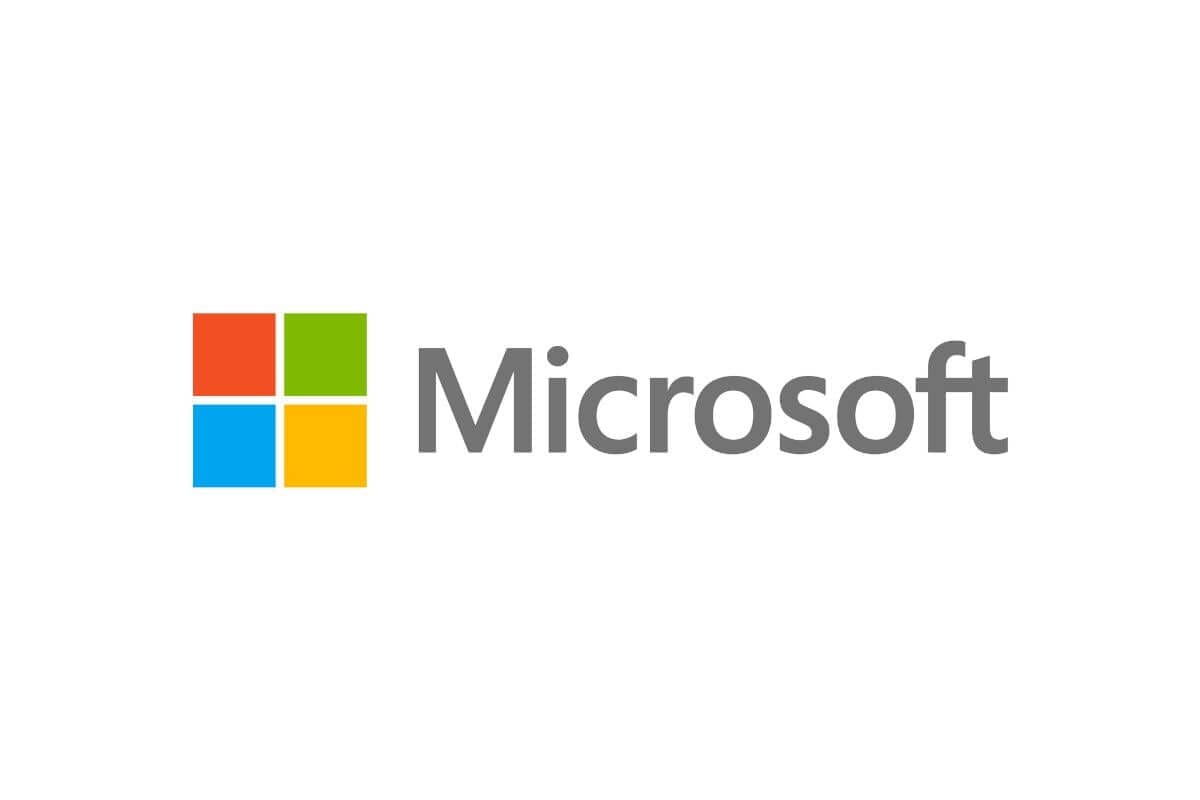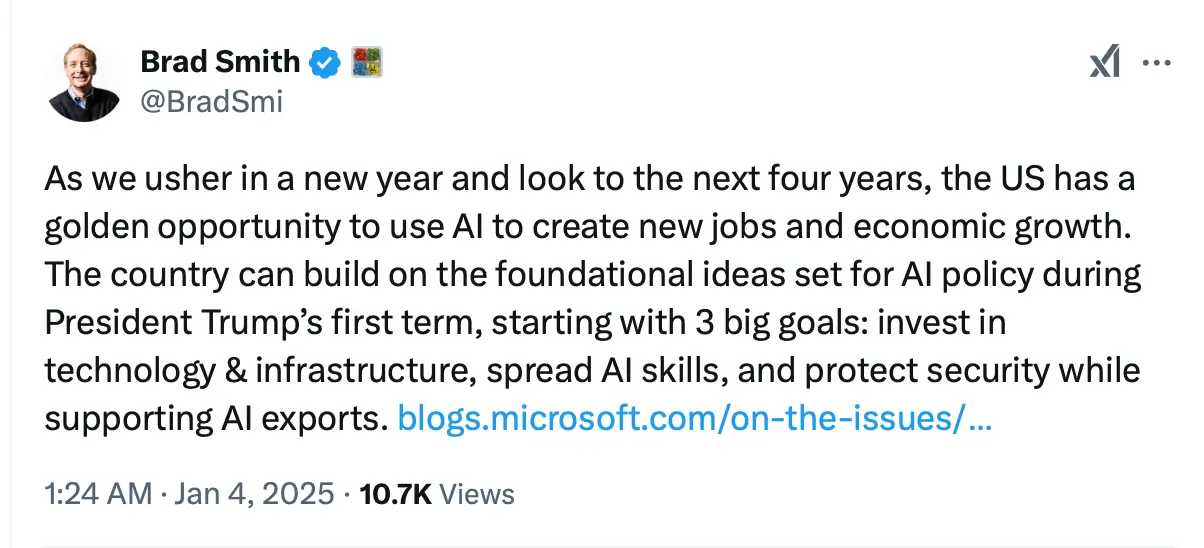
Microsoft Vice Chair and President Brad Smith on Friday said the company is on track to invest approximately USD 80 billion in FY 2025 to build out AI-enabled data centers to train AI models and deploy AI and cloud-based applications around the world. “More than half of this total investment will be in the United States, reflecting our commitment to this country and our confidence in the American economy,” Smith said in a blog post on January 3, 2025.
Also Read: OpenAI CEO Sam Altman Confident in Trump’s Support for AI
“As we usher in a New Year, we will welcome a new president into the White House as well as a golden opportunity for American technology and economic competitiveness,” Smith said, adding, “In many ways, artificial intelligence is the electricity of our age, and the next four years can build a foundation for America’s economic success for the next quarter century.”

Three-Part Vision for AI Leadership
“At Microsoft, we see a three-part vision for America’s technology success. This starts with advances and investments in world-leading American AI technology and infrastructure. Second, the country needs to champion skilling programs that will enable widespread AI adoption and enhanced career opportunities across the economy. Finally, the United States must focus on exporting American AI to our allies and friends, bolstering our domestic economy and ensuring that other countries benefit from AI advancements,” he explained.
“The country has a unique opportunity to pursue this vision and build on the foundational ideas set for AI policy during President Trump’s first term. Achieving this vision will require a partnership that unites leaders from government, the private sector, and the country’s educational and non-profit institutions. At Microsoft, we are excited to take part in this journey,” he added.
Also Read: OpenAI and Anduril Partner to Develop AI Solutions for US National Security
AI Technology and Infrastructure
“As we look into the future, it’s clear that artificial intelligence is poised to become a world-changing GPT (General-Purpose Technology, or GPT). AI promises to drive innovation and boost productivity in every sector of the economy. The United States is poised to stand at the forefront of this new technology wave, especially if it doubles down on its strengths and effectively partners internationally,” he highlighted.
“Today, the United States leads the global AI race thanks to the investment of private capital and innovations by American companies of all sizes, from dynamic start-ups to well-established enterprises,” Smith said. “At Microsoft, we’ve seen this firsthand through our partnership with OpenAI, from rising firms such as Anthropic and xAI, and our own AI-enabled software platforms and applications.”
“Across the nation, a new generation of AI firms is emerging, each capitalizing on rapid advances in AI models and chips, moving now from Graphics Processing Units (GPUs) to AI Accelerators with Tensors. And across the economy, software programs are being redesigned to operate as AI-enabled applications,” he said.
Also Read: OpenAI Targets 1 Billion Users by 2025 with AI Innovations and Apple Partnership: Report
Smith highlighted that since the Second World War, America’s technological innovation has been driven by research and development (R&D) based on two critical ingredients. The first is sustained support for basic research, and the second ingredient is a sustained commitment to investments in product development by companies of all sizes.
“The incoming Administration can strengthen these foundational elements, building on the work from President Trump’s first term. In 2019, the President approved an executive order designed to strengthen America’s lead in artificial intelligence. It rightly focused on federal investments in AI research and making federal data and computing resources more accessible. Five years later, President Trump and Congress should expand on these efforts to support advancing America’s AI leadership. More funding for basic research at the National Science Foundation and through our universities is one good place to start,” Smith wrote.
AI Skilling
Smith further explained that AI skilling has become a necessity for the nation. AI is reshaping the nature of work and the future of jobs. “AI, like all new technologies, will disrupt the economy and displace some jobs. But as we’ve worked on skilling initiatives during the past few years, our confidence has grown that AI will create new opportunities that will outweigh many of the challenges ahead.”
“Along the way, AI can boost productivity in every sector of the economy, adding to the country’s opportunity for economic growth.”
Train Americans with AI Skills
Smith highlighted that in 2025 alone, Microsoft is on a path to train 2.5 million American students, workers, and community members with the AI skills to land new jobs, pursue new careers, and build new businesses.
He also added that the National 4-H AI Skills Partnership will use Minecraft Education to introduce AI concepts and increase AI fluency for 1.4 million youth.
Also Read: Meta Expands Access to Llama AI Models for US Government Use
AI exports
Smith noted that the third critical priority for 2025 is the promotion of American AI exports. “Even more critically, the rapid development of China’s AI sector has heightened competition between American and Chinese AI, with much of this likely to play out during the next four years in international markets around the world,” he said.
“While the US government rightly has focused on protecting sensitive AI components in secure data centers through export controls, an even more important element of this competition will involve a race between the United States and China to spread their respective technologies to other countries. Given the nature of technology markets and their potential network effects, this race between the US and China for international influence likely will be won by the fastest first mover. Hence, the United States needs a smart international strategy to rapidly support American AI around the world,” he further added.
Also Read: Denmark Launches Guidelines for AI Implementation in Europe with Microsoft
“As we enter the second half of the decade, early signs suggest the Government of China is interested in replicating its successful telecommunications strategy. China is starting to offer developing countries subsidized access to scarce chips, and it’s promising to build local AI data centers,” Smith wrote. “The Chinese wisely recognize that if a country standardizes on China’s AI platform, it likely will continue to rely on that platform in the future.”
He added, “The best response for the United States is not to complain about the competition but to ensure we win the race ahead. This will require that we move quickly and effectively to promote American AI as a superior alternative. And it will need the involvement and support of American allies and friends.”
“The United States currently has multiple advantages. American companies currently have better technology, from chips to AI models to software applications. In addition, many US companies, including Microsoft, have invested heavily in building AI that is more trustworthy than most products from China. We are designing AI technology that protects cybersecurity, privacy, digital safety, and other responsible uses of AI. And we are making this technology available around the world through data centers that meet the US Government’s highest cyber and physical security standards,” he further said.
Also Read: AI Can Be a Game-Changer for Europe’s Economic Growth: Report
Smith highlighted the strong international regulatory cooperation among the North American, European, and Asian and Pacific democracies.
“Equally important, American tech companies and private capital markets are investing heavily to spread American AI platforms around the world,” he said, adding, “All this is creating a powerful approach that far exceeds what the United States and Europe had available to counter Chinese government subsidies in the telecommunications space.”
Also Read: Microsoft CEO Highlights the Human Impact of AI Across Sectors in 2024
Smith highlighted that Microsoft itself represents investment effort more than any other single entity. “Last year, we announced with national leaders that we intend to invest more than USD 35 billion in 14 countries within three years to build trusted and secure AI and cloud datacenter infrastructure. This is part of a global infrastructure that now reaches 40 countries, including in the Global South, where China has frequently focused so many of its Belt and Road investments.”
“To enhance our capabilities, we are partnering with the UAE’s sovereign AI company, G42, to bring AI infrastructure to Kenya. And we’re working with Blackrock and MGX to create an international investment fund to add up to USD 100 billion of additional funding for AI infrastructure and the AI supply chain.”
Also Read: ADNOC and AIQ Launch Agentic AI Solution for Energy Efficiency in Partnership with Microsoft
Smith noted that other companies are accelerating their investments as well, and companies such as Google, Amazon, and others are investing heavily. “But it will be difficult for China to match America’s private sector investments and these international capital funds,” Smith highlighted.
Optimistic about American AI
The vice chair summed up that looking to the four years ahead, there are many reasons to be optimistic about the role of American AI.
“Finally, the United States is in a strong position to win the essential race with China by advancing international adoption of American AI. American products are more trusted than their Chinese counterparts, and our private sector is unmatched in its ability to invest in infrastructure around the world. With a balanced and common-sense approach to export control policy, the United States can solidify the diplomatic relations that will be critical to global AI adoption,” Smith highlighted.


